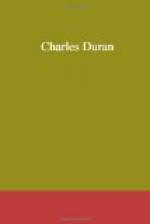CHAPTER I.
The Duran Homestead.
Before giving the history of Charles Duran’s birth, life, and early death, I will partially describe his father’s residence. It was situated in the town of ——, in the State of Connecticut, and about six miles from the west bank of the beautiful Connecticut river. The house stood on a level road, running north and south, and was about one mile from the centre of the town.
Mr. Duran’s house was large and commodious. It was built of wood, two stories high, and painted a deep yellow. In the front was a fine court-yard. In this yard were lilacs of a large growth, roses of various kinds, and flowering almonds. These shrubs blossomed early in the spring, and sent forth their fragrance to perfume the air.
On the south was a rich and well-cultivated garden, producing an abundance of vegetables, gooseberries, currants, and raspberries. The borders of the main alley were decked with pionies, pinks, and sweet-williams.
Between the garden and the house was the well. A long sweep, resting on the top of a high post, with a pole fastened to the upper end, was the rude contrivance for drawing water. To the lower end of the pole was attached a bucket. How many of New-England’s sons remember with delight the “old oaken bucket that hung in the well!”
On the north side of the house was a small orchard. In the rear were the barn, sheds, crib, and other out-buildings.
The grounds in the immediate neighborhood were level or slightly undulated. On the north and east were beautiful meadows. On the south and west were excellent tillage and pasture lands. The season that I spent there was one of nature’s bountifulness. The tall herd’s-grass, the rustling corn, and the whitened grain waved in the summer’s breeze, and bespoke the plenty that followed the toil and industry of the husbandman. The herds were feeding in the fields. The innocent lambs, free from care, were leaping and frisking about—some in the sun and some in the shade—while their more sober dames were either grazing, or quietly masticating the food they had previously collected.
Half encircling these premises was a fine stream of water, varying from three to seven yards in width. It was supplied with dace, trout, roach, and perch. Its plaintive, monotonous murmur sometimes impressed the mind with sadness. This was soon dispelled, however, by the twittering, the glee, and the sweet notes of the birds, that hopped from spray to spray, or quietly perched themselves on the overhanging branches.
Some little distance to the northwest of Mr. Duran’s house was a forest of thrifty growth, covered with a varied and beautiful foliage. Its shady bowers and pleasant walks made it a delightful place of resort,—especially toward the time of sunsetting. Nature seemed to lend to it then peculiar charms.




